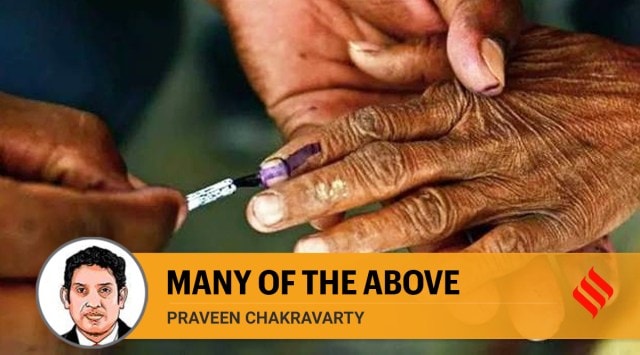MOTA - Many Of The Above - new election system

How India can prevent unnatural political alliances
No one can make an honest case that the parties on either side of the ideological spectrum are natural alliance partners, who are in perfect harmony with each other.
While these meetings seemingly reflect ideological-political formations, at their root, the primary driving force for such unity and alliance efforts is arithmetic. The aim is to ensure that votes of one formation do not get divided and the goal is to minimise splitting of votes on each side. In its naked form, these initiatives are merely a political response to the arithmetic of the first-past-the-post (FPTP) electoral system in India’s extremely diverse political landscape. The fountainhead of such electoral alliances among dozens of natural and unnatural parties is the fact that more than 600 parties contest the general elections and nearly three dozen parties have at least one member in Parliament, a uniquely Indian characteristic among major democracies in the world.
There may be no need for such elaborate initiatives to forcibly form electoral alliances among political parties if India dwindled to a two-party democracy like many other nations or if it evolved a better electoral method that does not reward the splitting of votes. In an extremely diverse society such as India, the proliferation of hundreds of political parties is a reflection of the need for representation. So, Indian politics cannot be force-fitted into a two-party system like other democracies. The FPTP method is incongruous with India’s unique political diversity. An alternative voting method, called “approval voting”, which is more aligned to prevent the splitting of votes among numerous parties, can potentially obviate the need for such elaborate and complex alliance and unity-building initiatives.
As an example, a voter in Uttar Pradesh (UP) has choices of four major parties — Samajwadi Party (SP), BJP, Bahujan Samaj Party (BSP) and Congress — and a few smaller parties such as Apna Dal and Rashtriya Lok Dal (RLD). She is expected to choose just one among all these choices to cast her vote for. She may choose to vote for Apna Dal, which, in turn, may be ideologically aligned with the BJP. But a vote for Apna Dal is deemed as a vote denied for the BJP in the FPTP voting method. So, it is tempting for the BJP to lure Apna Dal into a pre-poll alliance to ensure consolidation of such votes, even though there is no guarantee that every Apna Dal voter will automatically transfer their vote to a BJP-Apna Dal alliance.
Now, what if the voter in UP was not forced to choose just one party to vote for but was free to choose as many parties as she wants to? That is, the voter can choose both Apna Dal and BJP (say), indicating that she is agnostic between these two. This means that a vote for Apna Dal is not necessarily a vote denied for BJP and an explicit alliance between the two parties is not needed, since those who wish to vote for both are free to do so.
This system, called “approval voting”, is a well-researched voting methodology that is used in elections with multiple credible choices, such as in the United Nations, internal party primaries in the US, and sometimes in the election of the Pope. The winner is determined by the candidate with the greatest number of “approvals” or tick marks. In the Indian context, we can think of approval voting as MOTA (Many Of The Above), the mirror image of NOTA that we already have on every ballot.
MOTA legitimises this agnosticism without the need for a formal alliance and the risk of keeping that alliance post-election. MOTA can fundamentally change the dynamics of complicated political alliances, seat sharing, luring of parties post elections and institutionalisation of the politics of money and fear.
. Replacing the FPTP method with MOTA can fundamentally alter Indian politics and society for the better by reducing opportunistic political alliances in favour of ideological politics.
Comments
Post a Comment